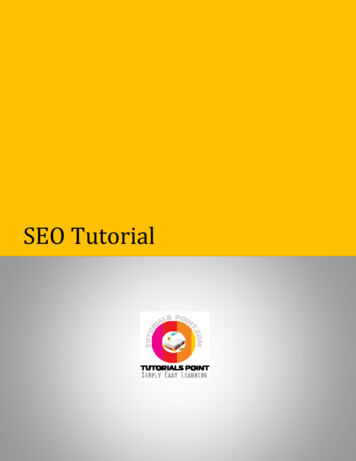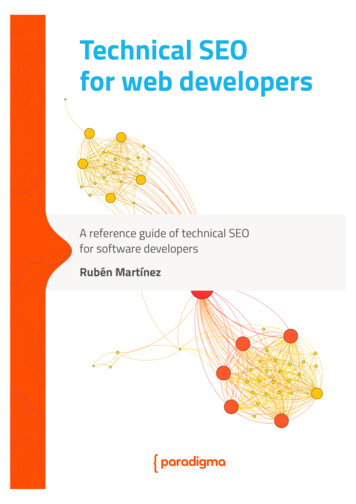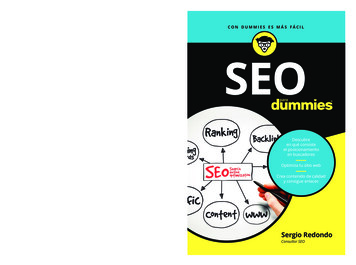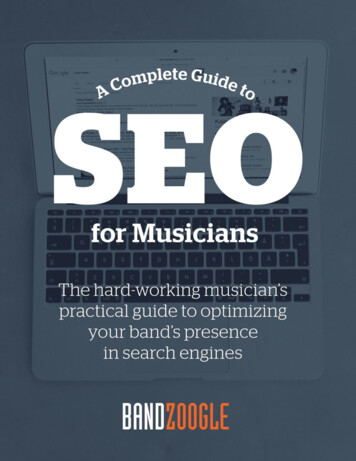
Transcription
SEO Tutorial
SEARCH ENGINE OPTIMZATIONSimply Easy Learning by tutorialspoint.comtutorialspoint.comi
ABOUT THE TUTORIALSEO TutorialSEO (Search Engine Optimization) is the activity of optimizing Web pages or whole sites in order to make them moresearch engine friendly, thus getting higher positions in search results.This tutorial will teach you simple SEO techniques to improve visibility of your web pages for different search enginesspecially for Google, Yahoo and Bing.AudienceThis tutorial has been prepared for the beginners to help them understand simple but effective SEO characteristics. Aftercompleting this tutorial you will find yourself at a moderate level of expertise in using simple but effective SEO techniquesfrom where you can take yourself to next levels.PrerequisitesWe assume you are aware of simple web technologies like HTML, XHTML, Style Sheet etc. If you already have developedany website then it is an added advantage and it will help you understand SEO concepts very easily.Copyright & Disclaimer Notice All the content and graphics on this tutorial are the property of tutorialspoint.com. Any content from tutorialspoint.com orthis tutorial may not be redistributed or reproduced in any way, shape, or form without the written permission oftutorialspoint.com. Failure to do so is a violation of copyright laws.This tutorial may contain inaccuracies or errors and tutorialspoint provides no guarantee regarding the accuracy of the siteor its contents including this tutorial. If you discover that the tutorialspoint.com site or this tutorial content contains someerrors, please contact us at webmaster@tutorialspoint.comii
Table of ContentsSEO Tutorial . iAudience . iPrerequisites . iCopyright & Disclaimer Notice . iWhat is SEO? . 1How Search Engine Works? . 1What is SEO Copywriting? . 2What is Search Engine Rank? . 2What is on-page and off-page SEO? . 2SEO Tactics and Methods . 3White Hat SEO . 3Black Hat or Spamdexing. 3SEO Website Domain . 5Guru Mantra . 5SEO Relevant Filename . 7File Naming Style. 7File Name Example . 7File Extension. 8URL Sub-Directory Name. 8Guru Mantra . 8SEO Design & Layout . 9SEO Optimized Keywords . 10Keyword Frequency: . 10Keyword Weight: . 10Keyword Proximity: . 10Keyword Prominence:. 11Keyword Placement: . 11Best Places to Put Keywords: . 11Finding Keywords: . 11What is Word Stemming? . 12SEO Optimized Meta tags . 13What do the Meta Tags Look Like? . 13iii
Meta Description Tag Tips: . 13Meta Keywords Tag Tips: . 14Robots Meta Tag: . 14SEO Title Optimization . 15Best Practices for Creating Titles: . 15SEO Optimized Anchors . 17Content Is The King. 18Unique, High-Quality Content: . 18SEO Content Writing ( Copy Writing ): . 19Other advantages of having great content: . 19Conclusion: . 19XHTML Verification for Web Site . 20Why HTML/XHTML Verification is Required?. 20What Is W3C Compliance? . 20Rules for W3C Compliance: . 21SEO Expert Hiring . 22Choosing a SEO Expert or Company:. 22SEO Link Building. 24How to increase Link Popularity? . 24Miscellaneous Techniques . 26Don't do the followings: . 26Do the followings: . 26SEO Summary . 28iii
1CHAPTERWhat is SEO?SEO is the activity of optimizing Web pages or whole sites in order to make them moresearch engine friendly, thus getting higher positions in search results.SEO is sometimes also called SEO copyrighting because most of the techniquesthat are used to promote sites in search engines deal with text. SEO Stands for Search Engine Optimization.SEO is all about optimizing a web site for Search Engines.SEO is the process of designing and developing a web site to rank well in searchengine results.SEO is to improve the volume and quality of traffic to a web site from searchengines.SEO is a subset of search engine marketing.SEO is the art of ranking in the search engines.SEO is marketing by understanding how search algorithms work and whathuman visitors might search.If you plan to do some basic SEO, it is essential that you understand how search engineswork and which items are most important in SEO.How Search Engine Works?Search engines perform several activities in order to deliver search results Crawling - is the process of fetching all the web pages linked to a web site. Thistask is performed by a software, called a crawler or a spider (or Googlebot, asis the case with Google).Indexing - is the process of creating index for all the fetched web pages andkeeping them into a giant database from where it can later be retrieved.Essentially, the process of indexing is identifying the words and expressions thatbest describe the page and assigning the page to particular keywords.Processing - When a search request comes, the search engine processes it . i.e.it compares the search string in the search request with the indexed pages in thedatabase.TUTORIALS POINTSimply Easy LearningPage 1
Calculating Relevancy - Since it is likely that more than one pages containsthe search string, so the search engine starts calculating the relevancy of each ofthe pages in its index to the search string.Retrieving Results - The last step in search engines' activities is retrieving thebest matched results. Basically, it is nothing more than simply displaying them inthe browser.Search engines such as Google and Yahoo! often update their relevancy algorithm dozensof times per month. When you see changes in your rankings it is due to an algorithmicshift or something else outside of your control.Although the basic principle of operation of all search engines is the same, the minordifferences between their relevancy algorithms lead to major changes in resultsrelevancy.What is SEO Copywriting?SEO Copywriting is the technique of writing the viewable text on a web page in such away that it reads well for the surfer, and also targets specific search terms. Its purpose isto rank highly in the search engines for the targeted search terms.As well as the viewable text, SEO Copywriting usually optimizes other on-page elementsfor the targeted search terms. These include the Title, Description and Keywords tags,headings and alt text.The idea behind SEO Copywriting is that search engines want genuine content pages andnot additional pages (often called "doorway pages") that are created for the sole purposeof achieving high rankings.What is Search Engine Rank?When you search any keyword using a search engine then it displays thousands of resultsfound in its database. A page ranking is measured by the position of web pages displayedin the search engine results. If Search engine is putting your web page on first positionthen your web page rank will be number 1 and it will be assumed as with a high rank.SEO is the process of designing and developing a web site to attend a high rank in searchengine results.What is on-page and off-page SEO?Conceptually, there are two ways of doing SEO On-Page SEO- This includes providing good content, good keywords selection,putting keywords on correct places, giving appropriate title to every page etc.Off-Page SEO - This includes link building, increasing link popularity bysubmitting in open directories, search engines, link exchange etc.TUTORIALS POINTSimply Easy LearningPage 2
2CHAPTERSEO Tactics and MethodsSEO techniques are classified into two broad categories:1.2.Techniques that search engines recommend as part of good design referred to asWhite Hat SEO, andTechniques that search engines do not approve and attempt to minimize theeffect of referred to as Black Hat or spamdexing.White Hat SEOAn SEO tactic, technique or method is considered as White Hat if it follows the followings If it conforms to the search engine's guidelines.If it does not involves any deception.It ensures that the content a search engine indexes and subsequently ranks isthe same content a user will see.It ensures that a Web Page content should have been created for the users andnot just for the search engines.It ensures the good quality of the web pagesIt ensures the useful content available on the web pagesAlways follow a White Hat SEO tactic and don't try to fool your site visitors. Be honestand definitely you will get something more.Next chapter onward we will put light on White Hap SEO techniques. The WHST are verysimple and can be done without investing much cost.Black Hat or SpamdexingAn SEO tactic, technique or method is considered as Black Hat or Spamdexing if it followsthe followings Try to improve rankings that are disapproved of by the search engines and/orinvolve deception.Redirecting users from a page that is built for search engines to one that is morehuman friendly.TUTORIALS POINTSimply Easy LearningPage 3
Redirecting users to a page that was different from the page the Search Engineranked.Serving one version of a page to search engine spiders/bots and another versionto human visitors. This is called Cloaking SEO tactic.Using Hidden or invisible text or with the page background color, using a tinyfont size or hiding them within the HTML code such as "no frame" sections.Repeating keywords in the Meta tags, and using keywords that are unrelated tothe site's content. This is called Meta tag stuffing.Calculated placement of keywords within a page to raise the keyword count,variety, and density of the page. This is called Keyword stuffing .Creating low-quality web pages that contain very little content but are insteadstuffed with very similar key words and phrases. These pages arecalled Doorway or Gateway PagesMirror web sites by hosting multiple web sites all with conceptually similarcontent but using different URLs.Creating a rogue copy of a popular web site which shows contents similar to theoriginal to a web crawler, but redirects web surfers to unrelated or malicious websites. This is called Page hijacking.Always be away to adopt any of the above Black Hat tactic to improve the rank of yoursite. Search engines are smart enough to identify all the above proprieties of your siteand ultimately you are not going to get anything.TUTORIALS POINTSimply Easy LearningPage 4
3CHAPTERSEO Website DomainWhen you start thinking of doing a business through internet, first thing whichyou think about is your web site domain name. Before you choose a domain name youshould consider the followings Who would be your target audience?What you intend to sell to them. Is it a tangible item or just text content?What will make your business idea unique or different than everything else thatis already on the market?Many people think it is important to have keywords in a domain. Keywords in the domainname are usually important, but it usually can be done while keeping the domain nameshort, memorable, and free of hyphens.Using keywords in your domain name give you a strong competitive advantage over yourcompetitors. Having your keywords in your domain name can increase click through rateson search engine listings and paid ads as well as make it easier to Using your keywordsin get keyword rich descriptive inbound links.Avoid buying long, and confusing domain names. May people separate the words in theirdomain names using either dashes or hyphen. In the past the domain name itself was asignificant ranking factor but now search engines have advanced it is not very significantfactor anymore.Keep two to three words in your domain name it will be more memorable. Some of themost memorable websites do a great job of branding by creating their own word. Fewexamples are eBay, Yahoo!, Expedia, Slashdot, Fark, Wikipedia, Google.You should be able to say it over the telephone once and the other person should knowhow to spell it and they should be able to guess about what you sell.Guru MantraFinally, you should be able to answer yourself for the following questions: Why do you want to build your website? Why should people buy off your site andnot from other site? What makes you different from others?Who are your target audience and what you intend to sell to them?TUTORIALS POINTSimply Easy LearningPage 5
List 5 - 10 websites which you thing, they are they amazing. Now think why arethey amazing?Create 5 different domain names. Make at least 1 of them funny. Tell them to ahalf dozen people and see which ones are the most memorable. You will getmore honest feedback if the people do not know you well.Buy your domain name which is more catchy, memorable and relevant to yourbusiness.TUTORIALS POINTSimply Easy LearningPage 6
4CHAPTERSEO Relevant FilenameOne of the simplest methods to improve your search engine optimization is tolook at the way you name your files. Before writing this tutorial I did lot of research onfile names and found that search engines like Google give too much importance to filenames. You should think what you are going to put in your web page and then give arelevant file name to this page.Just try giving any keyword in Google search engine and you will find file nameshighlighted with the keyword you have given. So it simply proves that your file nameshould have appropriate keyword.File Naming Style The filename should preferably be short and descriptive. It’s always good to usesame keywords in file name as well as in page title.Don't use file names like service.htm or job.htm but use actual service name inyour file name like computer-repairing.htmDon't use more than 3-4 words in file name and separate them with hyphensrather than underscores. Try to use 2 keywords if possible.File Name ExampleHere are some file names which should be preferred from SEO as well as from user pointof view. mlwilson-brand-balls.htmlNotice that keywords are separated by hyphens rather than underscores. Google sees filenames as follows:seo-relevant-filename as seo relevant filename(good)TUTORIALS POINTSimply Easy LearningPage 7
But Google seesseo relevant filename as seorelevantfilename (not good)File ExtensionIt should be noticed that .html, .htm and .php and any other extension do NOTHING foryour visitors, and they are simply a means of offloading some of the work of configuringyour webserver properly onto your visitors. In effect you are asking them to tell yourwebserver HOW to produce the page, not which one?Many Web masters think that it’s a good idea to use filename without using extension. Itmay help you but not a whole lot.URL Sub-Directory NameFrom Search Engine Optimization point of view URL sub-directory name hardly matters.You try giving any keyword in any search and you will not find any sub-directory namematching with your keywords. But from user point of view you should keep very muchabbreviated sub-directory name.Guru MantraFinally, I will suggest to keep the following points in mind before naming your files: Use web page file name short, simple, descriptive and relevant to page content.Try to use maximum 3-4 keywords in your file name and these keywords shouldbe appeared in your web page title as well.Separate all keyword with hyphen rather than with underscore.Keep your sub directories name as shorter as possible.Keep the file size fewer than 101K though because Google chops almosteverything above that.TUTORIALS POINTSimply Easy LearningPage 8
5CHAPTERSEO Design & LayoutAweb site design and layout gives first impression about your site. There aresites which are too fancy and regular net surfers will just reach on those sites and willcome out even without creating a single click.Search Engines are very smart but after all they are software and not human being whowill read the content of their interest. If you make your site too complicated then SearchEngine would not be able to parse the content of your site properly and finally indexingwould not be efficient which will result in a low rank.The actual page content should have a keyword density of about 10% and should weighin at about 200 words - but there are as many opinions about this as there are SEOexperts. Some say keyword density should be 5% and some say it should be 20%. 10%works for me.Here are few guidelines which should be considered while designing a web page. You should have more text content than HTML elements.No frames. They are the enemies of Search Engines and Search Engines areEnemies of Frames.No ads if possible. Because most of the ads uses Java Script which is not advisedto be used.No JavaScript. If you need JavaScript, call it from an external file rather thandumping the code in the HTML file. JavaScript drop down menus prevent spidersfrom crawling beyond your homepage. If you use them, be sure to include textlinks at the bottom of the page.Nothing that does not fit perfectly into the page topic; There should be no doubtin the search engine's mind (or in he user's mind) what your page is about.No unnecessary directories. Keep your files as close to the root as possible.No fancy stuff (Flash, Splash, Animated Gifs, Rollovers etc.) unless absolutelynecessary.TUTORIALS POINTSimply Easy LearningPage 9
6CHAPTERSEO Optimized KeywordsWe are discussing everything in Web context so in web terminology a keywordis a term that a person enters into a search engine to find specific information. Mostpeople enter search phrases that consists of between two and five words. Such phrasesmay be called search phrases, keyword phrases, query phrases, or just keywords. Goodkeyword phrases are specific and descriptive.There are following concepts related to Keywords which helps in optimizing keywords ona web page.Keyword Frequency:This is calculated as how often does a keyword appear in a site's title or description. Youdon't want to go overboard with frequency, however, since on some engines if you repeata word too many times, you'll be penalized for "spamming" or keyword stuffing.In general though, repeat your keyword in the document as many times as you can getaway with, and up to 3-7 times in your META tags.Keyword Weight:This refers to the number of keywords appearing on your Web page compared to thetotal number of words appearing on that same page. Some search engines consider thiswhen determining the rank of your Web site for a particular keyword search.One technique that often works well is to create some smaller pages, generally just aparagraph long, which emphasize a particular keyword. By keeping the overall number ofwords to a minimum, you will increase the "weight" of the keyword you are emphasizing.Keyword Proximity:This refers to the placement of keywords on a Web page in relation to each other or, insome cases, in relation to other words with a similar meaning as the queried keyword.TUTORIALS POINTSimply Easy LearningPage 10
For search engines that grade a keyword match by keyword proximity, the connectedphrase .home loans. will outrank a citation that mentions .home mortgage loans.assuming that you are searching only for the phrase "home loans".Keyword Prominence:A measure of how early or high up on a page the keywords are found. Having keywordsin the first heading and in the first paragraph (first 20 words or so) on a page are best.Keyword Placement:WHERE your keywords are placed on a page is very important. For example, in mostengines, placing the keywords in the Title of the page or in the Heading tags will give itmore relevancy. On some engines, placing keywords in the link text, the part that isunderlined on the screen in a browser, can add more relevancy to those words.Best Places to Put Keywords:Here is a list of places where you should try to use your main keywords. Keywords in the title tag(s).Keywords in the meta name "description" Keywords in the meta name "keyword" Keywords in h1 or other headline tags.Keywords in the a href "http://yourcompany.com" keywords /a link tags.Keywords in the body copy.Keywords in alt tags.Keywords in !-- insert comments here comments ttp://www.keyword.com/keywordkeyword.htm.Finding Keywords:There are many different ways to find keywords for your website. Some good keywordideas are: Words people would search for to find your product or service.Problems your prospective customers may be trying to solve with your productor service.Keyword tags on competitors websites.Visible page copy on competitors websites.Related search suggestions on top search engines.By using an online tools like: Google Keyword ToolBy analyzing your website carefully and finding out proper keywords. This taskcan be done by expert SEO Copywriters.Pay attention to stemming for your keywords - Particularly to what the root wordis and what Google considers to be a match for that word when optimizing pagesover time.You can do brainstorming to identify correct keywords for your site.TUTORIALS POINTSimply Easy LearningPage 11
What is Word Stemming?Google uses word stemming. Word stemming allows all forms of the word - singular,plural, verb form as well as similar words to be returned for a given search query.So if someone types in "house plans", not only will pages that are optimized for thatphrase be returned, but so will pages that contain all variations of that phrase, forexample: "house plan", "house planning", "house planer".Hope you have some understanding on keywords and how to identify them and where touse them. Next chapter will explain you how to optimize Meta tags for better results.TUTORIALS POINTSimply Easy LearningPage 12
7CHAPTERSEO Optimized Meta tagsThere are two important Meta Tags and they are the meta description and metakeyword tags. Some search engines may display the meta description as part of thesearch results, but the meta keywords tags should not appear in search results.The general consensus among SEO experts is that meta tags are dead. Even so, many ofthese same experts continue to use meta tags in their own sites.For Google adding the Description Meta Tag won't result in a boost in the Search EngineResults Pages (SERPs), but the description might be used for the description for yourSERP listings in Google. Yahoo says they use the Keyword Meta Tag when it ranks apage. So it makes sense to add one for Yahoo and any other minor search engines thatstill use.What do the Meta Tags Look Like?You can add following in the head section of the web page: meta name "keywords"content "KEYWORD1 KEYWORD2 KEYPHRASE1 etc.about 30 to 40 unique words" meta name "description"content "An accurate, keyword-rich descriptionabout 150 characters" Meta Description Tag Tips:There are few important tips for good meta description tags: Use keywords in your meta description tag.Try not to repeat the words overly often, but try to use multiple syntaxes of yourkey words.There should not be more than 150 characters in a description meta tag of asingle web page.TUTORIALS POINTSimply Easy LearningPage 13
Use a different meta description tag for each page, as each page is different andstands a better chance of being found if you place a good title and description onit.Meta Keywords Tag Tips:There are few important tips for good meta keywords tags. Please refer to previouschapter on identifying good keyword. Use synonymsUse unique keywordsNo need to repeat any given phrase.You can repeat any word an unlimited amount of time as long as each time it ispart of a different phrase.Robots Meta Tag:The important Meta Tag that you may need sometime is the Robots Meta Tag which lookslike this:meta name "robots" content "noindex,nofollow" Using above meta tag you can tell to a spider or robot that you do not want some of yourpages indexed or that you do not want your links followed.TUTORIALS POINTSimply Easy LearningPage 14
8CHAPTERSEO Title OptimizationHope you understand the meaning of HTML TITLE tag which is put inside headtag. The page title (not to be confused with the heading for a page) is what is displayedin the title bar of your browser window, and is also what is displayed when you bookmarka page or add it to your browser Favorites.This is the one place on a web page where your keywords MUST be present. Correct useof keywords in the title of every page of your website is extremely important to Google particularly for the home page. If you do nothing else to optimize your site, remember todo this!The title shouldn't consist of much more than about 9 words or 60 characters, with yourkeywords used at the very beginning of the title. Since Google is looking for relevantkeywords in the title, this means you should NOT include your company name in the titleunless your company name is very well known.Improper or nonexistent use of titles in web pages will keep more websites out of toprankings on Google than any other factor except perhaps for a lack of relevant content ona page or a lack of quality links from other websites that point to your site.Best Practices for Creating Titles:Here are some best practices you should follow for creating titles on pages: Each page should have a unique title.If practical, try to include your Primary Keyword Phrase in every title of everypage.Begin the title of your home page with your Primary Keyword Phrase, followed byyour best Secondary Keyword Phrases.Use more specific variations to your Primary Keyword Phrase on your specificproduct, service, or content pages.If you must include your company name, put it at the end of the title.Use the best form, plural or singular, for your keywords based on whatWordTracker says is searched on more often.Don't overdo it - don't repeat your keywords more than 2 - 3 times in the titleMake sure the title tag is the first element in the head section of yourpage - this makes it easier to find by Google.TUTORIALS POINTSimply Easy LearningPage 15
TUTORIALS POINTSimply Easy LearningPage 16
9CHAPTERSEO Optimized AnchorsUse descriptive anchor text for all your text links. Most search engines consideranchor text of incoming links when ranking pages. Here is an example of anchor: a href "otherpage.htm" title "Anchor Title" Anchor Text /a Here are following important points to notice about anchors: The Anchor Title plays a very important roles and will be seen
SEO Tutorial SEO (Search Engine Optimization) is the activity of optimizing Web pages or whole sites in order to make them more search engine friendly, thus getting higher positions in search results. This tutorial will teach you simple SEO techniques to improve visibility of your web pages for different search engines










